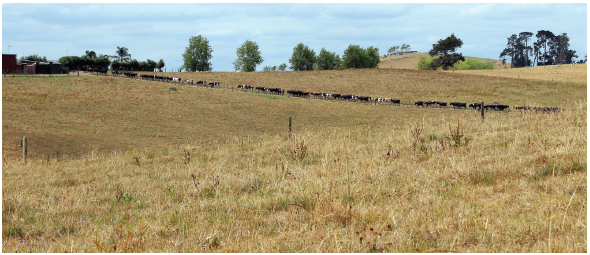Managing ryegrass on farm
Spring
Strong, healthy, well tillered ryegrass pastures will survive dry conditions better than those which are weak. So the aim for spring is to set up a robust, well tillered pasture prior to (a possibly dry) summer.
Daughter tillers
For perennial ryegrass, management through late spring is particularly important, because plants are vulnerable to stress as they change from vegetative to reproductive and back to vegetative growth. Most of the grass tillers in a pasture go to seed and die, and the pasture relies on new vegetative ‘daughter’ tillers to survive. These daughter tillers, and how many of them are developed through correct management, strongly influence summer and autumn growth.
Consistencyis key
During this period pasture covers should be kept consistently in the optimal grazing range.
Late spring is usually a period of surplus pasture growth. Strategies to help achieve good management at this time include removing paddocks from grazing to sow crop; making silage or hay; mowing pasture pre or post grazing or purchasing extra stock.
The worst management possible at this time is making heavy crops of silage or hay, as this shades and kills new daughter tillers.

Summer
Key challenges over summer are avoiding overgrazing, and increasing feed supply or reducing demand.
Extended dry
Short periods of moisture stress are common. The main problem for pasture persistence is extended dry periods which last for months. During these times, growth is limited, and the management priority is simple: maintain a strong pasture which will survive and re-grow once rain comes.
The big risk during extended dry periods is overgrazing, i.e. grazing below the normal residual, which damages the above-ground plant reserves. This comes from the tension between continued animal feed requirements and poor pasture growth. Overgrazing can slow regrowth, kill pasture plants and encourage weeds.
Minimise the risk
Farmers need systems in place to avoid overgrazing, or limit it to certain parts of the farm. The key tactic is on-off grazing, where animals are removed from the pasture when the desired post-grazing residual has been achieved, and put onto to a feed pad, crop stubble, lower value pasture, or paddock(s) earmarked for renewal.
Strategies to lift feed supply (e.g. supplements and summer crops) or reduce feed demand (e.g. selling trading stock or culls, OAD milking) are also critical to keep animals fed and protect pastures from overgrazing through dry periods.

Autumn
Key challenges are allowing pastures to recover following any extended dry spell, and dealing with insect attack.
Be patient
Once pastures receive significant rainfall, they must be allowed to recover before grazing. Farmers should continue their dry weather management strategies while pastures slowly start growing again.
Ryegrass pastures should only be grazed when ryegrass plants have produced 2.5-3 leaves per tiller, i.e. when plant energy reserves are replenished for good regrowth. Grazing prior to this may weaken and kill recovering pastures.

